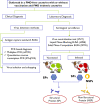Advances in the Diagnosis of Foot-and-Mouth Disease
- PMID: 32974392
- PMCID: PMC7473413
- DOI: 10.3389/fvets.2020.00477
Advances in the Diagnosis of Foot-and-Mouth Disease
Abstract
Foot-and-mouth disease (FMD) is a devastating livestock disease caused by foot-and-mouth disease virus (FMDV). Outbreaks of this disease in a country always result in conspicuous economic losses to livestock industry and subsequently lead to serious socioeconomic damages due to the immediate imposition of trade embargo. Rapid and accurate diagnoses are imperative to control this infectious virus. In the current review, enzyme-linked immunosorbent assay (ELISA)-based methods used in FMD diagnosis are extensively reviewed, particularly the sandwich, liquid-phase blocking, and solid-phase competition ELISA. The differentiation of infected animals from vaccinated animals using ELISA-based methods is also highlighted, in which the role of 3ABC polyprotein as a marker is reviewed intensively. Recently, more studies are focusing on the molecular diagnostic methods, which detect the viral nucleic acids based on reverse transcription-polymerase chain reaction (RT-PCR) and RT-loop-mediated isothermal amplification (RT-LAMP). These methods are generally more sensitive because of their ability to amplify a minute amount of the viral nucleic acids. In this digital era, the RT-PCR and RT-LAMP are progressing toward the mobile versions, aiming for on-site FMDV diagnosis. Apart from RT-PCR and RT-LAMP, another diagnostic assay specifically designed for on-site diagnosis is the lateral flow immunochromatographic test strips. These test strips have some distinct advantages over other diagnostic methods, whereby the assay often does not require the aid of an external device, which greatly lowers the cost per test. In addition, the on-site diagnostic test can be easily performed by untrained personnel including farmers, and the results can be obtained in a few minutes. Lastly, the use of FMDV diagnostic assays for progressive control of the disease is also discussed critically.
Keywords: complement fixation test (CFT); enzyme-linked immunosorbent assay (ELISA); foot-and-mouth disease virus (FMDV) diagnosis; lateral flow device (LFD); reverse transcription-loop-mediated isothermal amplification (RT-LAMP); reverse transcription-polymerase chain reaction (RT-PCR); reverse transcription-recombinase polymerase amplification (RT-RPA); virus neutralization test (VNT).
Copyright © 2020 Wong, Yong, Ong, Ho and Tan.
Figures

References
-
- OIE Foot & Mouth Disease (FMD) [Online] (2018). Available online at: http://www.oie.int/en/animal-health-in-the-world/animal-diseases/Foot-an... (accessed June 13, 2020).
Publication types
LinkOut - more resources
Full Text Sources

